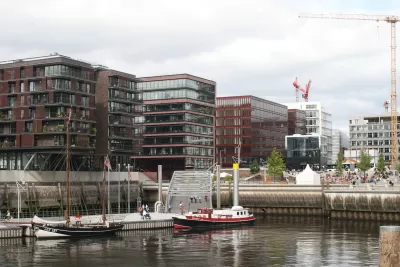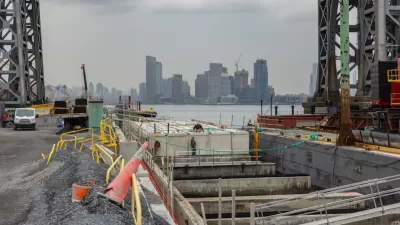A riverside neighborhood in Hamburg embraces flooding as part of its resilience planning, using old techniques to protect modern communities.

HafenCity, a development in the German port city of Hamburg, sits outside the city's main flood protection dike. Yet the community is being hailed as "a model for climate change resilience," writes Peter Yeung, thanks to its innovative use of centuries-old techniques that mitigate the effects of flooding, which is anticipated to become more severe as extreme weather worsens.
Rather than fight the flooding, some of HafenCity's structures, like the public promenades along the river and retrofitted brick warehouses, are built to withstand being flooded. "It’s a dramatic example of how a city can plan new development around the certainty of future flooding. While Hamburg sits more than 100 kilometers from the North Sea, its lowlands are vulnerable both to storm surges and heavy rainfall."
While most of the city is protected by a dike, HafenCity fell outside the area which could reasonably and affordably be integrated into the dike's domain. Its designers used another ancient Dutch technique: the terp. "Based on an ancient Dutch technique for building atop artificial mounds, the practice predates the modern era of seawalls" and promotes "[t]he concept of living with water rather than attempting to wall it off." The practice is also used in other parts of Hamburg to mitigate seasonal flooding. These strategies are coupled with a Storm Surge Warning Service that broadcasts announcements and provides information in the event of more unpredictable, catastrophic events.
Hamburg's success provides useful lessons for flood adaptation strategies that "focus on flexible, multi-use designs that are nature-based."
FULL STORY: In Hamburg, Surviving Climate Change Means Living With Water

Alabama: Trump Terminates Settlements for Black Communities Harmed By Raw Sewage
Trump deemed the landmark civil rights agreement “illegal DEI and environmental justice policy.”

Study: Maui’s Plan to Convert Vacation Rentals to Long-Term Housing Could Cause Nearly $1 Billion Economic Loss
The plan would reduce visitor accommodation by 25% resulting in 1,900 jobs lost.

Planetizen Federal Action Tracker
A weekly monitor of how Trump’s orders and actions are impacting planners and planning in America.

Wind Energy on the Rise Despite Federal Policy Reversal
The Trump administration is revoking federal support for renewable energy, but demand for new projects continues unabated.

Passengers Flock to Caltrain After Electrification
The new electric trains are running faster and more reliably, leading to strong ridership growth on the Bay Area rail system.

Texas Churches Rally Behind ‘Yes in God’s Back Yard’ Legislation
Religious leaders want the state to reduce zoning regulations to streamline leasing church-owned land to housing developers.
Urban Design for Planners 1: Software Tools
This six-course series explores essential urban design concepts using open source software and equips planners with the tools they need to participate fully in the urban design process.
Planning for Universal Design
Learn the tools for implementing Universal Design in planning regulations.
Caltrans
Smith Gee Studio
Institute for Housing and Urban Development Studies (IHS)
City of Grandview
Harvard GSD Executive Education
Toledo-Lucas County Plan Commissions
Salt Lake City
NYU Wagner Graduate School of Public Service





























